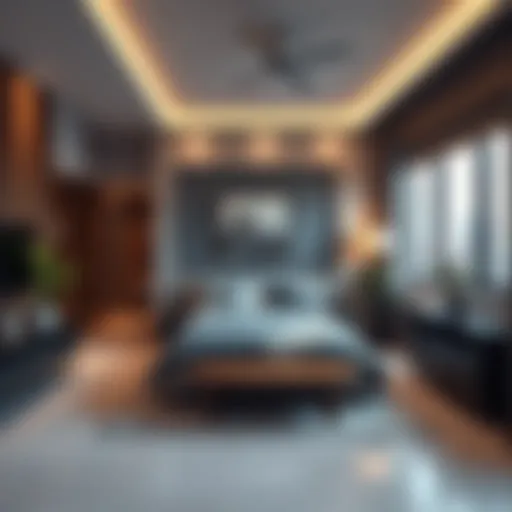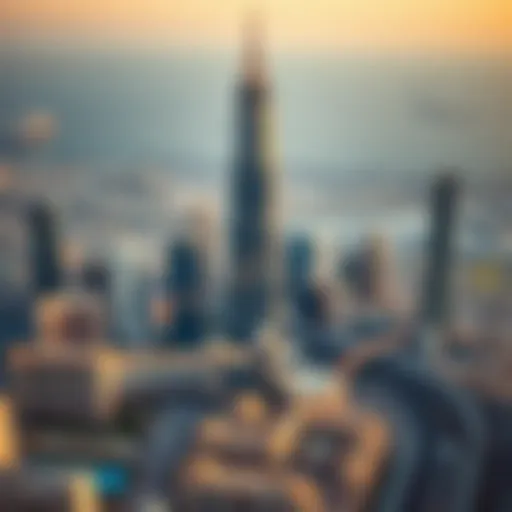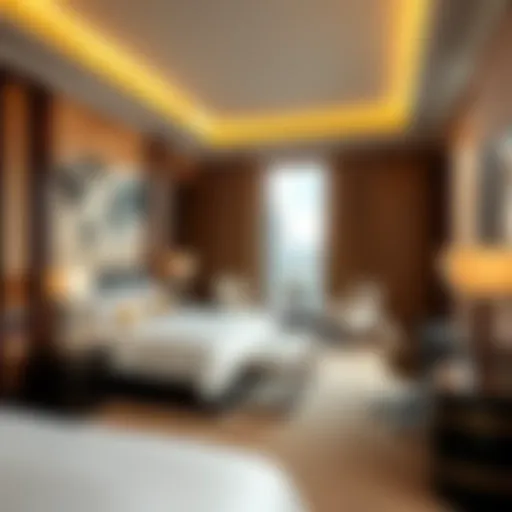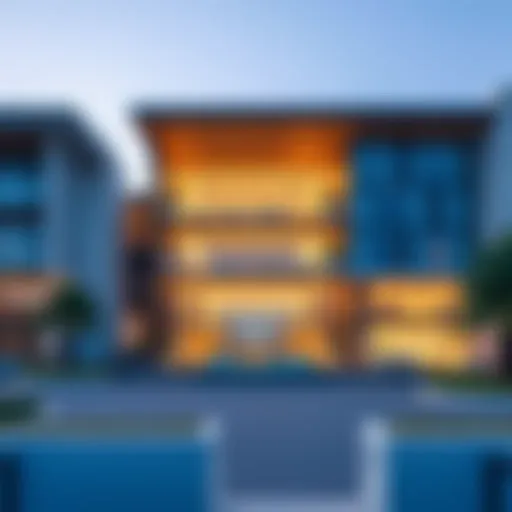Navigating the Dubai Metro: Your Essential Guide
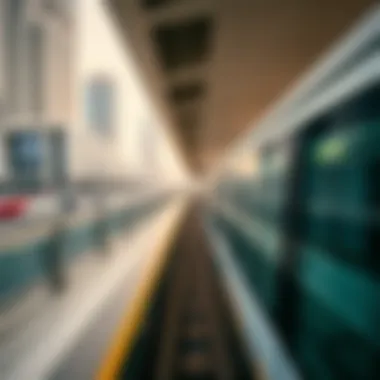
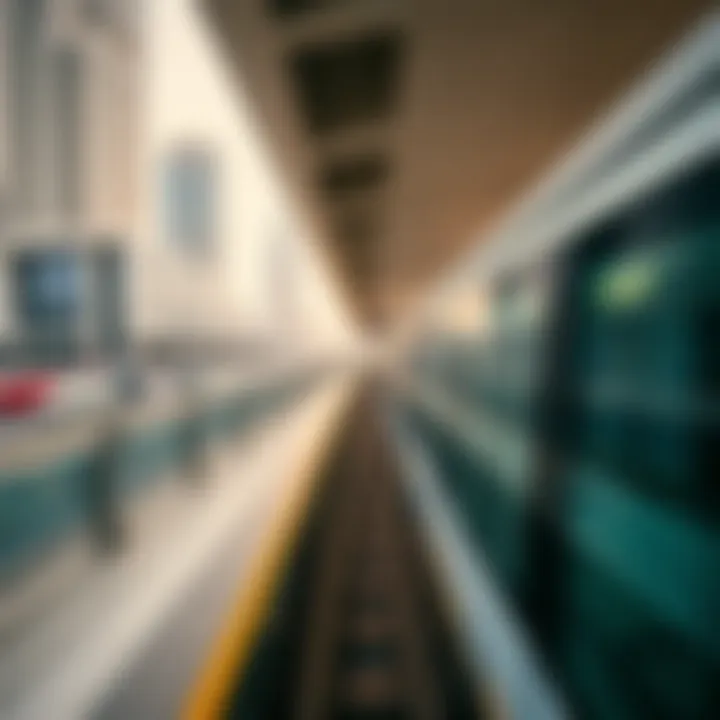
Intro
Dubai's metro system serves as more than just a means of transportation; it epitomizes the city's ambition and commitment to innovative urban planning. For those who live or work in the bustling metropolis, the metro is a lifeline that connects key areas and streamlines daily commutes amid the vibrant cityscape. As we embark on this comprehensive exploration, we will delve into various aspects of the metro system, particularly its routes and stations, which enhance urban mobility.
Understanding how the metro functions is critical for investors, homebuyers, and real estate agents as it directly influences property values and market dynamics. Moreover, this guide will discuss market trends and property types that are intrinsically linked to the performance and expansion of the metro network.
By analyzing the interface between the metro and Dubai's real estate realm, we will cover pivotal insights ranging from current market conditions to future predictions. This not only benefits commuting residents but also offers a strategic advantage for those looking to make informed investment choices. It’s a tale of connectivity, growth, and opportunity that we’re set to unravel.
Overview of the Dubai Metro System
The Dubai Metro stands as a testament to the city's rapid growth and modernization. This automated transport system is more than just a way to get from point A to B; it is a vital piece of infrastructure that reshapes urban mobility in Dubai, interacting closely with the city’s economic and residential landscapes. Understanding the Dubai Metro System is crucial for investors, homeowners, and urban planners alike, as it impacts not only daily commutes but also property values and urban planning initiatives. With a sprawling network that connects key areas of the city, the Metro enhances accessibility and reduces traffic congestion, making it indispensable for any discussion about Dubai's urban development.
History and Development
The inception of the Dubai Metro dates back to the early 2000s. Spearheaded by the Roads and Transport Authority (RTA), the vision was clear: to create a world-class transport system that could cater to the needs of a growing population. The first stretch, the Red Line, was inaugurated in 2009 and immediately made an impact, not just in improving connectivity but also in promoting sustainable urban living. Over the years, the network has expanded significantly, with the introduction of new lines such as the Green Line and ongoing plans for future expansions. This historical trajectory highlights the ambition and forward-thinking nature of Dubai’s urban planners.
Infrastructure and Design
Dubai Metro’s infrastructure is a marvel of modern engineering. The system consists of elevated tracks, underground sections, and an extensive network of stations, each uniquely designed to reflect the city’s rich culture and heritage. The stations are not mere stops; they are landmarks in their own right, combining functionality with artistic expression. For instance, the Mall of the Emirates station doubles as a shopping destination, seamlessly blending transport and retail.
The design emphasizes accessibility, safety, and comfort. Each station is equipped with facilities catering to all, including elevators and designated seating for those with reduced mobility. The aesthetic touches, from the murals to the high ceilings, create an inviting environment for commuters, reinforcing the image of Dubai as a global hub.
Operational Overview
In terms of day-to-day operation, the Dubai Metro runs with remarkable efficiency. With trains arriving every few minutes, commuting has never been more convenient. Operational hours typically extend from early morning until midnight during the weekdays, with slightly reduced hours on weekends. This schedule accommodates the diverse lifestyles of Dubai’s residents and visitors.
The ticketing system utilizes the Smart NOL Card, enabling seamless travel across different modes of public transport. This integration simplifies the commuting experience, reducing waiting times and enhancing the overall effectiveness of the metro system. The operation is characterized by a strong emphasis on safety and security, with extensive surveillance and a dedicated team to respond to any emergencies.
In summary, the Dubai Metro System is not merely a mode of transport; it’s a cornerstone of the city’s infrastructure that influences commuting habits, urban growth, and real estate values. Understanding its history, infrastructure, and operational dynamics provides invaluable insights for investors and residents navigating the ever-evolving Dubai landscape.
Key Metro Lines
The Key Metro Lines of Dubai are more than mere routes; they form the backbone of the city’s public transportation system, connecting people to work, leisure, and everyday activities. Understanding these lines is essential for anyone navigating the vibrant tapestry of Dubai’s urban landscape. The two main lines, the Red Line and the Green Line, not only ease congestion on the roads but also contribute significantly to the city’s economic and social framework.
Red Line
The Red Line stretches approximately 52 kilometers, from Rashidiya in the east to UAE Exchange in the west. It serves as a major arterial route, making stops at significant landmarks like Dubai Mall, Burj Khalifa, and Dubai Marina. Its strategic path helps facilitate access to both commercial centers and residential neighborhoods. Commuters can expect frequent services, especially during peak hours, making it a reliable choice for daily travel.
Moreover, the Red Line acts as a catalyst for development along its route. Properties located near its stations see increased demand, thereby boosting real estate ventures in these areas. This has made it particularly attractive for investors looking for properties that promise value appreciation.
The Red Line isn’t just about transit; it's about transforming urban connectivity and accessibility.
Green Line
Conversely, the Green Line is shorter at about 23 kilometers and runs from Al Qusais to Dubai Creek, paralleling the Red Line but focusing more on residential communities. This line is essential for connecting areas that are not serviced by the Red Line, hence completing a wider network of public transport. Key stops include Al Gubaiba and Dubai Health Authority, ensuring that both cultural and health institutions are easily reachable for residents and visitors alike.
The Green Line also plays a significant role in enhancing accessibility for lower-income neighborhoods, providing those residents with better access to jobs and essential services. Its significance is not only in facilitating mobility but also in its contribution to social equity.
Future Expansions
Looking ahead, future expansions of the Dubai Metro promise to revolutionize urban transport even further. Plans are in place to extend both the Red and Green Lines, targeting areas that have seen recent development and where greater mobility options are needed.
These expansions aim to include additional stops in emerging business districts and newly-built residential zones. With rapid urbanization, it is crucial to keep pace with population growth and ensure that the metro system is equipped to meet current and future transportation demands. This level of foresight is essential for maintaining the efficiency of urban transit and supporting sustainable economic growth in Dubai.
Investors should keep a keen eye on these developments, as properties near upcoming metro stations can provide lucrative investment opportunities. For those involved in real estate, understanding how transit expansions can affect property values is key to making informed decisions.
Metro Stations: A Closer Look
The Dubai Metro system is not just a means of transportation; it is a critical artery that pumps life into the city’s urban ecosystem. Each metro station serves as a microcosm of Dubai’s diversity and innovation, catering not just to commuters, but also to tourists, businesses, and local residents. By examining the metro stations in detail, we uncover not just their architectural prowess but also their strategic importance in shaping the urban landscape and enhancing commuter experience.
Major Stations
When you think of the metro in Dubai, certain stations might spring to mind due to their size, design, or location. Burj Khalifa/Dubai Mall Station is one such prominent stop. It provides access to one of the tallest buildings and the largest shopping mall worldwide—an essential hub for both tourists and locals. The station's impressive design complements the striking skyline, serving as a gateway to luxury experiences.
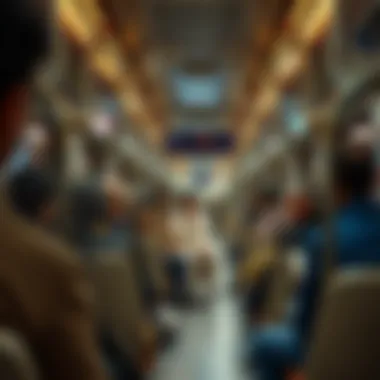

Another key station is the Dubai Marina Station. This station is not only a transit point but also a social gathering space, surrounded by parks and trendy restaurants. Here, riders can enjoy views of the boats lining the marina, making it a popular choice for those looking to unwind after work or on weekends.
- Key Major Stations:
- Burj Khalifa/Dubai Mall Station
- Dubai Marina Station
- Union Station (a key interchange)
- Mall of the Emirates Station
Each of these stations plays a unique role, steering the flow of people and encouraging economic activity in their vicinity.
Accessibility Features
In an ever-evolving city like Dubai, accessibility cannot be overlooked. The metro system is built with a focus on inclusivity, with features designed to cater to people of all abilities. Most stations are equipped with ramps, elevators, and tactile guide paths for visually impaired passengers. Moreover, clearly marked signage in several languages helps diverse populations navigate the system with ease.
"The Dubai Metro’s commitment to accessibility highlights a progressive vision, making it easier for everyone to participate in the urban life of this vibrant city."
This thoughtful design ensures that everyone, from families with strollers to individuals with disabilities, can utilize the metro without undue burden. Accessibility is not just a feature; it’s a guiding principle.
Interconnectivity with Other Transit Options
An effective metro system must link seamlessly with other modes of transport. The Dubai Metro does just that, enhancing the convenience for commuters. For instance, Union Station and Burjuman Station serve as vital hubs, connecting the Red and Green Lines and facilitating transfers to buses, taxis, and the future introduction of tram services.
Additionally, the metro’s arrangement with ride-hailing services like Uber and Careem offers commuters flexibility, allowing them to cover the last mile more conveniently. The result is a transportation network that integrates land, air, and sea travel smoothly, ensuring that whether you're commuting for work or leisure, the city is at your fingertips.
- Key Interconnected Services:
- Buses at major stations
- Taxi ranks at interchanges
- Future tram lines
Overall, the metro stations of Dubai are carefully conceived hubs that illustrate the city’s dedication to modernity, inclusivity, and connectivity. By exploring these stations, we not only appreciate the architectural beauty but also grasp their significant role in enhancing urban mobility in a fast-paced metropolis.
Impact on Urban Mobility
The metro system in Dubai has become a cornerstone for urban mobility, reshaping how residents and visitors navigate this bustling metropolis. Its significance extends beyond mere transportation; it influences daily routines, boosts the economy, and plays a pivotal role in sustainable urban development.
Enhancing Commuter Experience
Dubai's metro aims not just to move people from point A to B, but to elevate the whole commuting experience. The efficiency of the metro, exemplified by its punctuality, reduces the daily hassle faced by commuters. This is particularly crucial in a city where traffic congestion has been a long-standing issue. Using the metro can cut down commute times, allowing individuals to reclaim hours that would otherwise be spent stuck in traffic.
A comfortable environment is also high on the agenda. The stations and trains are designed with modern amenities that cater to diverse passenger needs. Cleanliness, safety, and accessibility are prioritized, making it easier for people whether they have mobility challenges or just a long day ahead of them. In addition, the integration of advanced technologies enhances the user experience, with features such as real-time updates and mobile app functionalities that keep commuters informed.
Furthermore, efficiency breeds reliability—knowing the trains will come on time fosters a sense of trust among users. This trust encourages more residents to opt for public transport, effectively decreasing car usage. As more people board trains, the pressure on road infrastructure diminishes, leading to a more organized city flow.
Ecological Benefits
The ecological benefits attributed to Dubai's metro system cannot be overlooked. By promoting the use of public transportation, the emirate is making strides toward reducing carbon emissions significantly. Traditional vehicles emit a considerable amount of greenhouse gases, contributing to air pollution and deteriorating environmental quality. The metro stands as a cleaner alternative, encouraging a shift towards sustainable travel options.
Additionally, fewer cars on the roads lead to a decrease in noise pollution and road wear. The metro's footprint is far less disruptive than that of individual vehicles, preserving green spaces and enhancing urban livability. Initiatives like energy-efficient trains and a focus on utilizing renewable energy further underline the commitment to sustainability.
"The metro not only redefines how we travel; it whispers a promise of a greener, more sustainable future for our ever-growing city."
These benefits are not only good for the planet; they also resonate with eco-conscious investors. Properties near metro stations see a rise in demand, as they are often perceived as more desirable due to their lower environmental impact. This practical intersection of urban planning and ecological mindfulness is steadily molding a more interconnected and eco-friendly Dubai.
Real Estate Insights: Metro Proximity
The intersection of Dubai's thriving real estate market and its metro system is a topic that deserves thorough exploration. Proximity to metro stations can significantly alter the desirability and value of properties. This is not just an idle observation; it's a trend observed across major cities worldwide. In Dubai, the metro’s influence is palpable, affecting everything from rental rates to the kinds of developments sprouting in its vicinity.
Attractiveness of Properties Near Metro Stations
When considering where to invest or buy a home in Dubai, metro accessibility stands out as a major draw. Properties situated within walking distance of metro stations tend to command higher interest from buyer and renter demographics. Why? Here are the reasons:
- Convenience: The ease of commuting translates into less time stuck in traffic, which is a huge selling point for professionals and families alike.
- Cost Efficiency: For many, the ability to save on transportation costs by relying on the metro system is appealing.
- Lifestyle Change: Being near metro stations encourages a lifestyle devoid of constant reliance on a car, which is evermore attractive to the environmentally conscious.
Some developments have even tailored their designs to complement metro access. For instance, mixed-use buildings housing shops, restaurants, and residential units can make commuting more appealing.
Changes in Property Values
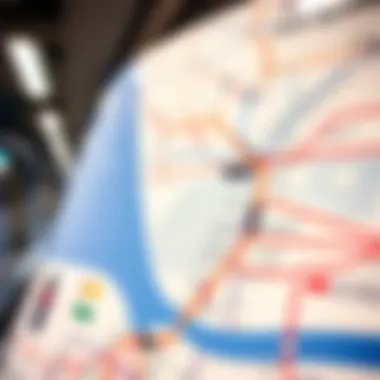
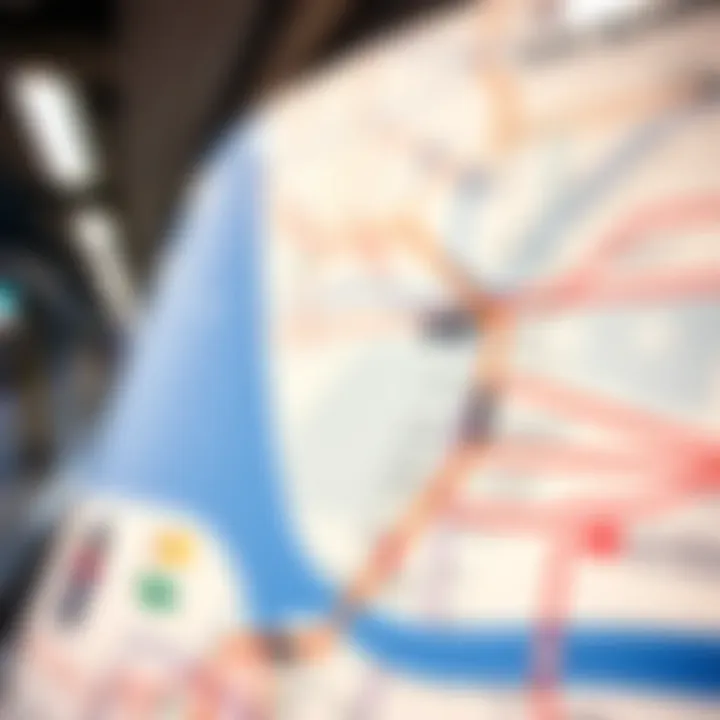
The proximity to metro stations does not just bring cosmetic changes; it affects property values substantially. Price fluctuations can stem from various factors:
- Increased Demand: As mentioned earlier, properties close to metro lines often see increased demand. This heightened interest can lead to inflation in property prices.
- Transitional Areas: Areas once considered undesirable may flourish as metro lines extend, transforming those neighborhoods into hotspots for both business and habitation. Homes or apartments that might have settled at lower prices previously can experience significant appreciation.
- Market Analysis: Current trends show that locations nearest to metro stations often yield better long-term investment returns.
For instance, properties near the Burj Khalifa Metro Station typically see a year-on-year value increase as more businesses locate nearby, making those properties highly coveted.
Investor Perspectives
For those on the lookout for promising investments, the metro's reach cannot be ignored. Investors often keep a keen eye on:
- Rental Yields: Properties near metro stations tend to offer better rental yields, due to their attractiveness to commuters.
- Resale Values: Investors look for areas where future line expansions may occur, predicting growth in property values as the network evolves.
- Diversification of Portfolio: By including metro-adjacent properties in their portfolios, investors can safeguard against downturns in more traditional areas, offering a hedge against market changes.
"Investments in metro-adjacent properties can yield rich dividends, especially in a rapidly evolving city like Dubai."
Therefore, understanding the relationship between Dubai’s metro system and real estate dynamics is essential. Investing in areas with metro access may not only offer immediate benefits but also solid long-term value gains as the city continues to expand and modernize.
To follow up on these insights, one can explore further resources on Dubai’s property landscape at Dubai Property and the Dubai Land Department.
Operational Hours and Ticketing System
Understanding the operational hours and ticketing system of the Dubai Metro is crucial for anyone looking to navigate this vibrant city with ease. The metro is not just a mode of transport; it's a lifeline connecting various neighborhoods and enhancing the urban experience. Getting familiar with when the metro operates and how the ticketing works can make a significant difference in a commuter's day.
Operating Times
The Dubai Metro operates with defined timings that cater not only to daily commuters but also to late-night revelers.
- Weekdays (Saturday to Thursday): The metro runs from 5:00 AM until midnight. This schedule helps accommodate those heading to work early in the morning and offers a reliable transport option for evening commuters.
- Fridays: The starting time shifts slightly to 10:00 AM, allowing for the observance of religious practices. It then operates until 1:00 AM the following day, making it a viable option for weekend outings.
It's imperative to note that schedules can vary, particularly when it comes to public holidays and special events. Always keep an eye on potential adjustments, especially during Eid or the Dubai Shopping Festival, where extended hours may provide additional convenience.
Ticket Pricing Structure
Understanding the ticket pricing structure can ease the process of planning the journey and managing the budget. The pricing is designed to be affordable, accommodating a range of travelers. Here’s a closer look:
- Standard fare: Depends on the distance traveled. The fare ranges from 3 to 8 AED, with longer journeys costing a bit more.
- Categories: There are also special pricing categories, such as children, senior citizens, and people with disabilities who are eligible for discounted fares.
- Types of Tickets: Travelers can choose between a single journey ticket or a multiple journey ticket with further discounts for bulk purchases.
The smart NOL card not only simplifies the payment process but also offers users considerable savings, making it a wise choice for frequent travelers.
Smart NOL Card Utilization
The NOL card is a game-changer when it comes to travel on the Dubai Metro.
- Convenience: Instead of purchasing a ticket for each ride, users can top up a NOL card and simply tap at the entrance and exit gates. This streamlines the boarding process, reducing wait times at busy stations.
- Flexibility: The NOL card can also be used on other modes of public transport in Dubai, including buses and water taxis, presenting an integrated approach to public transit.
- Discounts & Bonus: Additional savings are available through various promotions; reloading the card sometimes comes with bonus credit, further optimizing public transport expenses.
In summary, familiarizing oneself with the operational hours and ticketing system of the Dubai Metro is not just a matter of logistics, but a way to enhance one's experience of the city's diverse landscapes. A well-planned journey makes all the difference, ensuring smooth transitions across the metropolitan expanse.
Safety and Security Measures
The importance of safety and security measures within the Dubai Metro system cannot be understated. As one of the busiest metro networks in the world, ensuring the well-being of commuters and maintaining a secure environment for all users is paramount. With the increasing ridership and the expanding network, it is essential to look closely at the various facets of safety and security that Dubai Metro employs. Not only do these measures protect passengers, but they also enhance the overall experience of commuting in the city.
Surveillance and Monitoring
Dubai Metro is equipped with state-of-the-art surveillance systems, which play a critical role in ensuring passenger safety. The use of high-resolution cameras is prevalent throughout the stations and within the trains themselves. This extensive network of cameras allows for real-time monitoring and detection of any irregular activities.
To break it down further:
- Real-time monitoring: This enables security personnel to respond immediately to any incidents.
- CCTV footage storage: Recorded data can be reviewed in case of a security breach or safety incident, aiding investigations.
- Visibility: Having visible cameras acts as a deterrent to any potential wrongdoing.
Benefits of Surveillance Systems
- Enhanced Safety: The presence of surveillance systems lowers the likelihood of crimes.
- Incident Response: Quick reaction times in emergencies can save lives.
- Public Confidence: A visible security presence can boost commuter confidence, drawing more people to use the metro for transportation.
Emergency Response Protocols
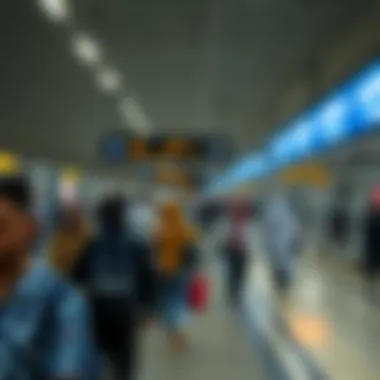
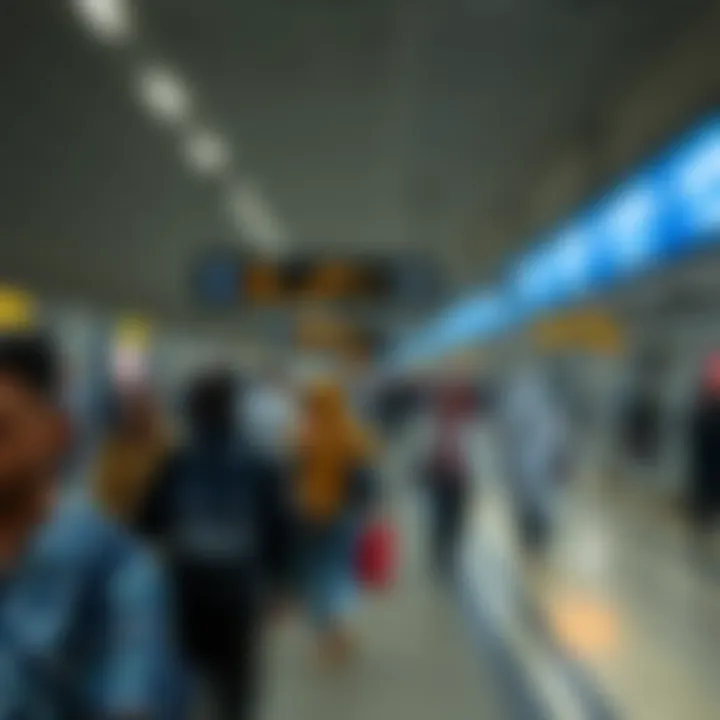
In addition to surveillance, the presence of comprehensive emergency response protocols ensures that in the event of an incident, the situation can be managed swiftly and effectively. These protocols are designed to address a range of emergencies, from medical issues to security threats.
Some essential aspects of these protocols include:
- Training of Staff: All metro staff undergo rigorous training in emergency situations, equipping them to handle various scenarios.
- Evacuation Plans: Clear procedures are established to guide passengers to safety quickly and efficiently.
- Coordination with Local Authorities: The metro collaborates with local emergency services to ensure a comprehensive response mechanism.
- Regular Drills: Frequent drills help staff stay prepared and ready to act when required.
Ensuring safety in public transport systems is not only a priority but a necessity, fostering a reliable environment for all commuters.
Key Takeaways
The investment in safety through surveillance and emergency protocols demonstrates Dubai Metro's commitment to passenger welfare. This focus not only enhances the daily commuting experience but also serves as a model for urban transport systems worldwide. For investors and homebuyers, this robust safety framework adds another layer of appeal to properties linked with the metro's extensive network.
In summary, a well-secured transit network not only protects its users but also fosters trust, encouraging more individuals to utilize the metro, which in turn strengthens its vital role in the urban landscape.
Cultural Significance of the Metro
The cultural significance of the Dubai Metro extends beyond its function as a transportation system. It embodies the spirit of a city that seamlessly merges tradition with modernity. For investors and homebuyers, understanding this significance can offer insights into community values and the evolving landscape of urban living in Dubai.
Art and Design in Stations
The metro stations in Dubai serve as more than just transit points; they are galleries showcasing the rich heritage and artistic expression of the Emirati culture. Each station is thoughtfully designed to reflect both local art and global aesthetics. For instance, the Mall of the Emirates Station features intricate mosaics that echo Abu Dhabi's traditional architecture, while the Burjuman Station has art installations that evoke the city's rapid urbanization and futuristic outlook.
One notable example is the Dubai Health Authority Station, which integrates health-related themes into its design. This station includes murals celebrating wellness and vitality, making the station an engaging environment for commuters. The blending of functionality and artistic expression enhances the overall commuter experience, attracting more visitors and residents alike to its vibrant atmosphere.
Moreover, these artistic endeavors not only beautify the city but also act as a catalyst for local artists, providing them with a platform to showcase their work on a grand scale. Such initiatives are crucial for fostering a sense of pride among residents and offering tourists a glimpse into the cultural fabric of Dubai.
Community Engagement Initiatives
The metro system actively seeks to engage with the community through various initiatives aimed at fostering a sense of belonging and shared identity among residents. One such initiative is the Metro Art Program, which invites local artists to create installations and art pieces that resonate with the cultural history of the area. Events like Art in Transit bring communities together, allowing them to participate in workshops and exhibitions that promote local talent and creativity.
Additionally, the metro conducts awareness campaigns focused on sustainability, encouraging riders to adopt eco-friendly practices. Such campaigns underscore the metro’s commitment to not just being a mode of transport but also a leader in promoting sustainable urban living.
Furthermore, community programs enhance social cohesion, encouraging diverse populations to interact and share experiences. By fostering engagement, the metro system effectively strengthens ties among residents, making it a cornerstone of social life in Dubai.
“The metro serves as a bridge, connecting people not just geographically, but culturally and socially.”
Challenges and Future Developments
The evolution of the Dubai Metro system is far from a one-and-done affair; it is a continuously unfolding story that also grapples with a myriad of challenges. These hurdles present both obstacles and opportunities for enhancing the metro's overall impact and efficiency. Addressing these issues could not only improve the operational functionality of the metro but also integrate it more seamlessly into the urban development plans that Dubai has in the pipeline.
Maintenance and Upkeep
Metro systems require diligent maintenance and upkeep to ensure safety and reliability of service. The Dubai Metro, with its innovative technology and sophisticated infrastructure, is no different. Regular monitoring and upkeep are essential to extend the lifespan of the trains and tracks, as well as to minimize disruptions for commuters.
The operational team must navigate numerous layers of complexities, from technical repairs to routine inspections. A prominent example is the annual thorough examination of the trains, which is done meticulously to prevent any unforeseen breakdowns. This is complemented by proactive off-site inspections carried out to catch issues before they escalate. Such measures not only ensure efficiency but also foster trust among daily commuters.
Regular maintenance can be costly, but it’s an investment worth making. The goal is often to balance service availability with sustainability, ensuring the metro meets the demands of growing ridership without compromising on quality or safety.
- Key Maintenance Focus Areas:
- Train inspections
- Track and signaling systems
- Station facilities
Maintaining excellence requires resources, both human and financial. Therefore, partnerships with technology providers and maintenance firms may be pursued to ensure the highest standards are maintained.
Integration with Future Urban Planning
Dubai's metro holds critical importance in its future urban planning strategies. As the city continues to grow and evolve, integrating the metro system with future developments is essential. This means not only expanding the metro’s reach but doing so in a way that complements other modes of transportation, such as buses, taxis, and even waterways.
Incorporating the metro into new urban development zones adds a layer of convenience for residents and businesses alike. It's not just about laying down tracks; it involves strategic planning to develop Transit-Oriented Developments (TOD). These developments around metro stations can reimagine the social landscape, turning areas into vibrant hubs where living, working, and leisure blend seamlessly.
"A well-planned metro will ease congestion on the roads and contribute profoundly to both the environment and the economy of Dubai."
It also helps to minimize the environmental footprint of urban growth, reducing reliance on cars and outdoor pollution levels. The foresight in planning can make a substantial difference in the city's livability, guiding future generations toward sustainable practices.
- Considerations for Integration:
- Multi-modal transport systems
- Eco-friendly designs
- Community engagement initiatives
In sum, while challenges exist, they bring with them the potential to elevate the Dubai Metro into something that does not just serve as a mode of transportation but as a cornerstone in the city’s design and livability for years to come.





